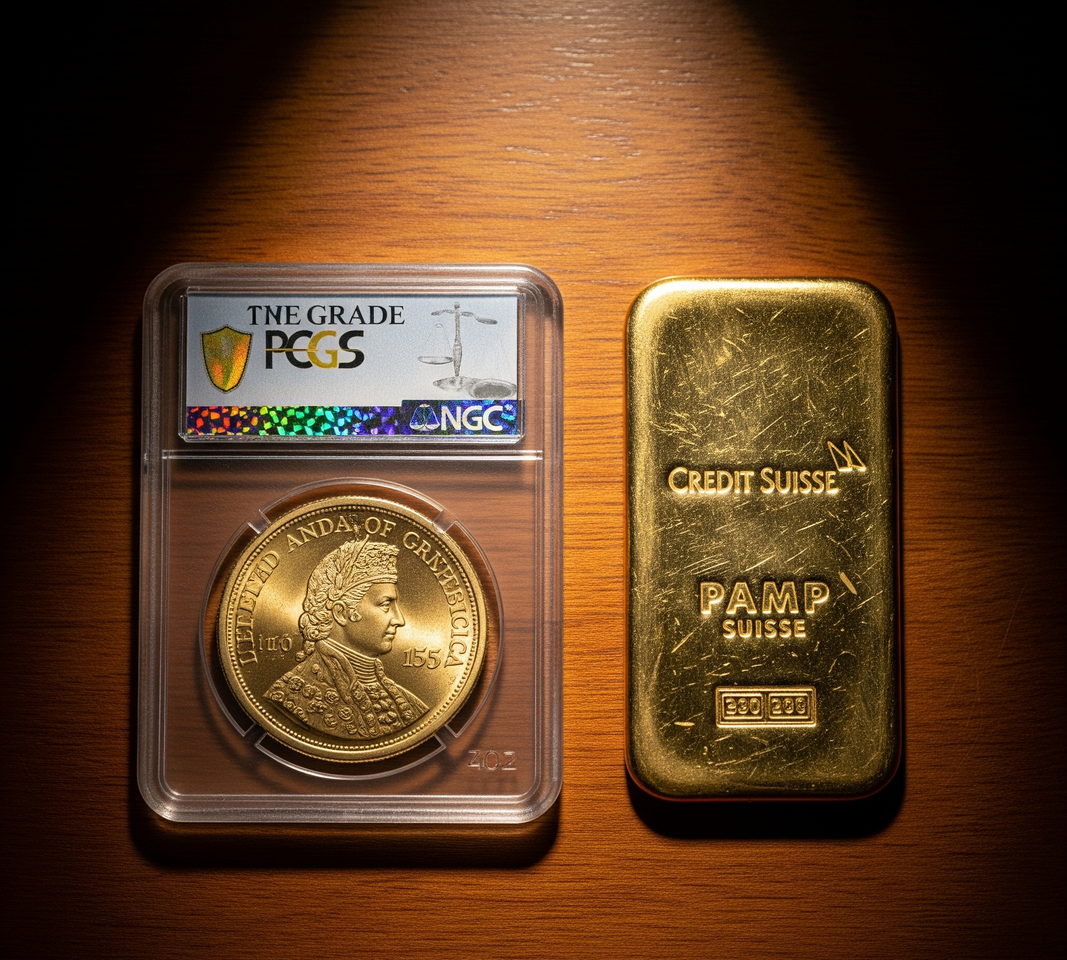Beyond Gold & Silver: Unlocking the Hidden Value of Numismatic Assets for Your Portfolio
1. Executive Summary: The Numismatic Asset Class at a Glance
Numismatics, the study and collection of currency, represents a distinct and compelling asset class that offers a compelling case for inclusion in a diversified investment portfolio. Contrary to the common perception of coins and paper money as simple precious metal bullion, the value of numismatic assets is not tied to their intrinsic metal content. Instead, their valuation is governed by a sophisticated framework of non-correlated factors, including rarity, condition, and historical significance. This report analyzes the investment potential of numismatics, demonstrating its historical performance and its role as a hedge against inflation and economic uncertainty.
Historical performance data presents a robust argument for the asset class. The PCGS3000 Key Dates and Rarities Index, a prominent numismatic benchmark, has shown a compound annual return of 14% since 1971, historically outperforming traditional equities like the Dow over the same period. Furthermore, a Penn State study found that high-quality numismatic coins yielded an average annual return of 12.2% over a 35-year span. These returns are particularly notable for their low correlation with traditional financial markets, as the market has historically surged during periods of high inflation and stock market turmoil.
While the potential for significant appreciation exists, the numismatic market is characterized by a high degree of specialization and unique risks. The market is opaque, can be illiquid, and is subject to counterfeiting and the subjectivity of professional grading. Therefore, success in this asset class requires rigorous due diligence, a long-term investment horizon, and a strategic focus on certified, high-quality assets. For the financially literate investor willing to navigate its complexities, numismatics provides a powerful tool for portfolio diversification and long-term wealth preservation.
2. The Investment Case for Numismatics: Beyond the Melt Value
2.1 Defining Numismatics vs. Bullion
A fundamental distinction exists between numismatic assets and precious metal bullion. Bullion, such as a one-ounce gold bar or a modern coin like the Canadian Maple Leaf, derives its value primarily from its weight and purity, which are directly tied to the fluctuating global spot price of its metal content.
In contrast, the value of a numismatic item is fundamentally disconnected from its material composition. It is an asset where "extrinsic factors" drive value. For a financially literate audience, this can be understood through a simple case study using the Morgan Silver Dollar. While a common date Morgan dollar in average, circulated condition may trade for only a small premium over its silver melt value, a rarer date from the same series in a high, uncirculated grade can be worth thousands of dollars.
2.2 Historical Performance and Low Correlation: A Deeper Look
The historical performance of the numismatic market presents a compelling case for its inclusion in a diversified portfolio. The PCGS Rare Coin Index, a basket of rare coins, was established at a value of $1,000 on January 1, 1970.
However, a closer look at the data reveals a crucial market dynamic. While the long-term returns are impressive, the market is not without its cycles and periods of significant volatility. The PCGS 20th Century Coin Index, for example, reached an all-time high of $102,248.62 in May 1989.
A key benefit of numismatics is its low correlation with traditional assets.
The following table provides a comparative overview of the historical performance of the numismatic index against other major asset classes.
| Asset Class | Performance (1970-2023) | Key Driver(s) | Correlation with S&P 500 |
| PCGS Rare Coin Index | +7,070% | Rarity, Grade, Demand | Low, Counter-cyclical |
| S&P 500 | +2,800% | Corporate Earnings, Macro-Economics | High |
| Dow Jones | +2,000% | Corporate Earnings, Macro-Economics | High |
| Gold Bullion | +1,800% | Inflation, Geopolitical Risk, Industrial Demand | Low |
2.3 Tangibility and Finite Supply
Numismatic assets are physical, tangible items. This characteristic offers a level of security and control that is not present in purely digital or paper-based financial instruments.
3. The Anatomy of Value: A Three-Pillar Framework
The value of a numismatic asset is determined by a framework of three interconnected pillars: rarity, condition, and demand. For the investor, understanding the interplay of these factors is essential for accurate valuation and strategic acquisition.
3.1 Pillar I: Rarity
Rarity is the most crucial factor in determining a numismatic item's value. Rarity is not simply a matter of a low original mintage, which is the total number of items produced by the mint. More importantly, it is defined by the "certified population," which is the number of items known to have survived in a collectible or graded state. A coin with a high original mintage may still be exceptionally rare if a large number of them were later melted down or were lost to time. For example, certain Morgan Silver Dollar varieties, particularly those from the Carson City mint, command a significant premium due to their low production figures.
3.2 Pillar II: Condition & Grading
The physical preservation of a numismatic item is paramount. The industry-standard for assessing a coin's condition is the 70-point Sheldon Scale, originally developed in 1949 and later modified for wider use.
A single-point increase in a coin's grade on the Sheldon Scale can have a disproportionate and dramatic impact on its financial value. This can be particularly pronounced when a coin crosses a key threshold, such as from an MS-64 to a “gem” grade of MS-65.
It is important for a potential investor to recognize that professional grading, while standardized by leading services like the Professional Coin Grading Service (PCGS) and the Numismatic Guaranty Company (NGC), is still based on human judgment and can be subjective.
The following table demonstrates the profound financial impact of a single-grade increase using data from the Morgan Silver Dollar, a popular and widely-traded coin series.
| Coin Example | Grade | Approximate Value Range | Value Jump (MS-64 to MS-65) |
| 1880-O Morgan Dollar | MS-64 | $1,319 - $1,639 | >8x increase |
| MS-65 | $12,495 | ||
| Common Date Morgan | MS-64 | $700 - $1,000+ | ~3x increase |
| 1878 Morgan Dollar | MS-65 | $2,300+ |
3.3 Pillar III: Demand & Historical Significance
The final pillar of value is demand, which is often amplified by a numismatic item's "story". This narrative component—its historical significance, a famous designer, or its place in a popular collecting series—transforms a simple coin into a desirable artifact with a large pool of potential buyers.
4. A Gallery of Value: Iconic Numismatic Transactions
4.1 Coinage: The Pinnacle of Rarity and History
The numismatic market is defined by a small number of iconic, record-breaking sales that illustrate the asset class's ability to generate exceptional value.
-
The 1794 Flowing Hair Silver Dollar: This coin represents a milestone in American history, being the first official silver dollar struck by the U.S. Mint.
21 21 21 22 -
The 1787 Brasher Gold Doubloon: Created by goldsmith and silversmith Ephraim Brasher, a neighbor of George Washington, this coin is considered a crowning achievement of early American coinage and the epitome of numismatic rarity.
23 23 24 -
The 1943 Copper Lincoln Penny: The value of this coin is a pure reflection of rarity based on a minting error. During World War II, copper was a critical material needed for munitions, leading the U.S. Mint to produce cents from zinc-coated steel.
25 25 25 4
4.2 Paper Currency: The Holy Grail
The high-value numismatic market extends beyond coins to include paper currency.
-
The 1890 "Grand Watermelon" Treasury Note: Widely regarded as the "Holy Grail of American Currency," the 1890 United States $1,000 Treasury Note is a legendary piece of U.S. financial history.
27 27 27 28
5. Mitigating Risk: Due Diligence and Strategic Entry
The numismatic market, while potentially rewarding, is not without its risks. Navigating this specialized field requires a disciplined approach and a commitment to due diligence.
5.1 The Expertise Gap: "Buy the Book Before the Coin"
The numismatic market is highly specialized, and without a foundational understanding, investors are vulnerable to poor decisions.
5.2 Authenticity and Counterfeit Risk
The high value of certain numismatic items makes them a prime target for counterfeiters and fraudulent activity.
The most effective way to mitigate the risk of counterfeiting and misrepresentation is to exclusively acquire items that have been certified and encapsulated by reputable third-party grading services like PCGS and NGC.
5.3 Market Dynamics and Investment Strategy
Numismatic assets, particularly high-end rarities, are less liquid than traditional investments or even precious metal bullion.
When considering an investment strategy, a balanced approach is advised. Numismatics should be seen as a "complement" to, rather than a "replacement" for, a traditional portfolio of stocks and bonds.
6. Conclusion: Numismatics in a Diversified Portfolio
Numismatics offers a distinctive and valuable opportunity for sophisticated investors seeking to diversify their portfolios with tangible assets. The evidence presented in this report establishes that the value of these assets is driven by immutable, non-correlated factors—rarity, condition, and historical significance—and their historical performance has been both robust and compelling, particularly during periods of economic instability.
However, the numismatic market is complex and carries inherent risks related to its opacity, illiquidity, and the prevalence of counterfeiting. Success in this field is not a matter of chance or passive investment but of rigorous, active due diligence. Therefore, a potential investor should adhere to three core principles:
-
Educate before you invest. The market's complexity demands a high degree of specialized knowledge. Prioritize learning about a specific niche and building relationships with reputable dealers and collectors.
-
Adopt a long-term investment horizon. The market is cyclical, and the high transaction costs necessitate a holding period of at least 10 years to realize meaningful returns.
-
Prioritize quality and professional certification. Rely on established third-party grading services like PCGS and NGC to ensure authenticity and an objective assessment of condition, thereby mitigating the most significant risks in the market.
For the disciplined investor who is willing to approach it as a serious and long-term endeavor, numismatics is a valid, distinct, and potentially rewarding component of a well-diversified portfolio. It offers not only the prospect of financial returns but also the unique privilege of owning a piece of history.
Explore Popular Articles
More Than Money: The Tangible Assets Drawing a New Crowd
The New Golden Age of Collecting A Market Transformed by Youth, Technology, and Value For decades,...
The Collector's Hierarchy
The Collector’s Hierarchy Understanding Issued, Specimen, and Proof Banknotes In the sophisticated...
The Great Revaluation: Strategic Outlook on Commodities, Equities, and the Return of Tangible Assets (2025–2026)
Executive Summary: The Pivot to Tangible Value The global financial architecture is currently navi...




